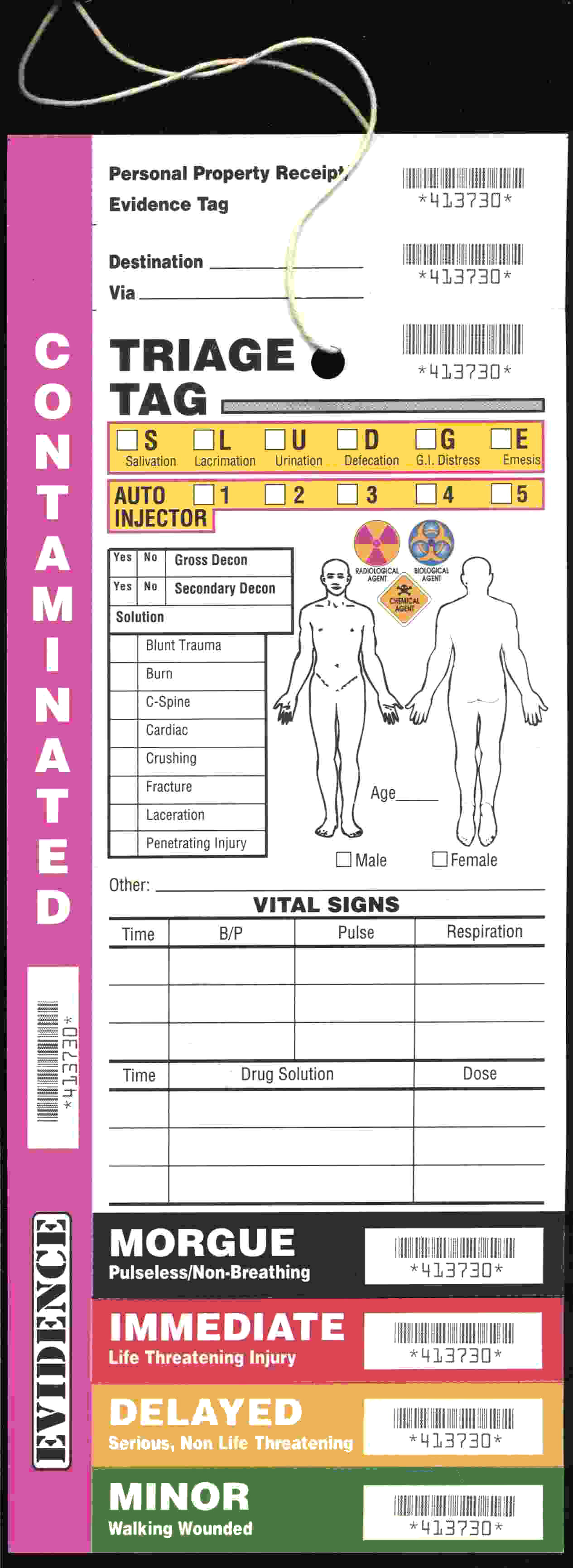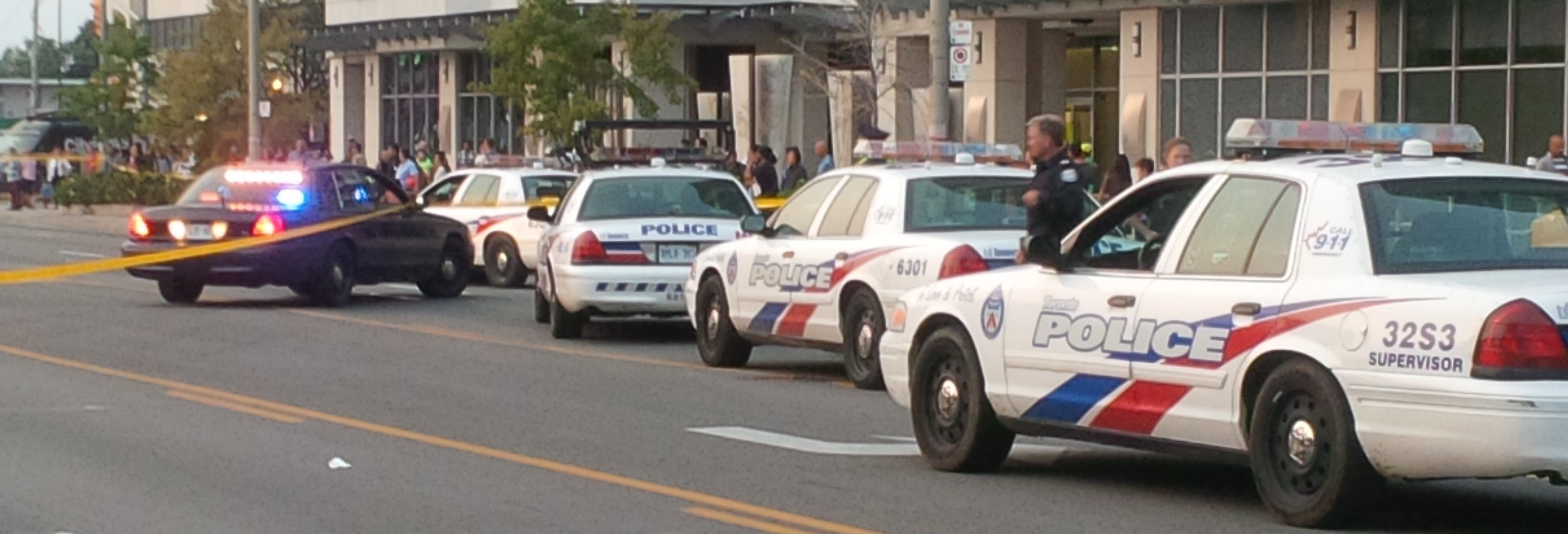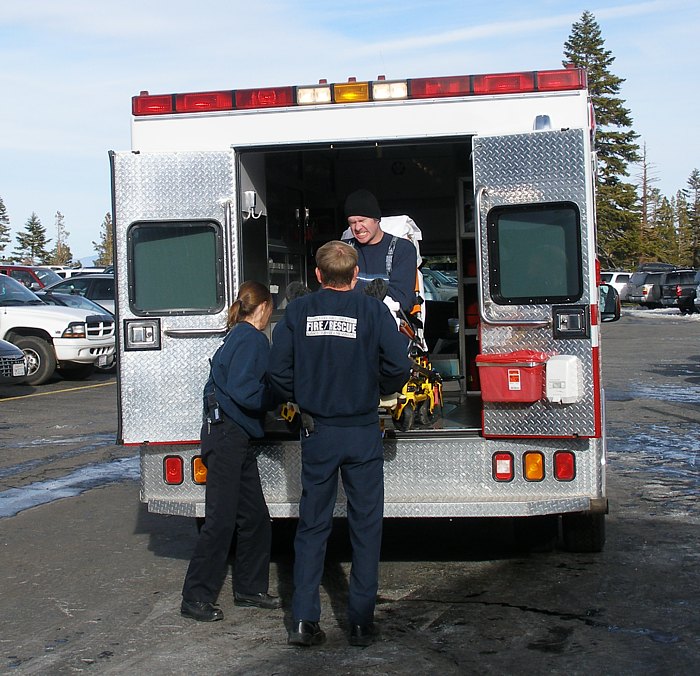|
Triage Tag
A triage tag is a tool first responders and medical personnel use during a mass casualty incident. With the aid of the triage tags, the first-arriving personnel are able to effectively and efficiently distribute the limited resources and provide the necessary immediate care for the victims until more help arrives. Triage tags were first introduced by Dominique Jean Larrey, Baron Dominique Jean Larrey, a French surgeon in Napoleon I of France, Napoleon's army. Simple triage and rapid treatment (Simple triage and rapid treatment, START) is a strategy that the first responders and medical personnel employ to evaluate the severity of injury of each victim as quickly as possible and tag the victims in about 30–60 seconds. The triage tags are placed near the head and are used to better separate the victims so that when more help arrives, the patients are easily recognizable for the extra help to ascertain the most dire cases. Design A triage tag is two-sided, but the actual layout ... [...More Info...] [...Related Items...] OR: [Wikipedia] [Google] [Baidu] |
Mass Casualty Incident
A mass casualty incident (often shortened to MCI) describes an incident in which emergency medical services resources, such as personnel and equipment, are overwhelmed by the number and severity of Casualty (person), casualties. For example, an incident where a two-person crew is responding to a motor vehicle collision with three severely injured people could be considered a mass casualty incident. The general public more commonly recognizes events such as building collapses, train and bus collisions, plane crashes, earthquakes and other large-scale emergencies as mass casualty incidents. Events such as the Oklahoma City bombing in 1995, the September 11 attacks in 2001, and the Boston Marathon bombing in 2013 are well-publicized examples of mass casualty incidents. The most common types of MCIs are generally caused by terrorism, mass-transportation accidents, fires or natural disasters. A multiple casualty incident is one in which there are multiple casualties. The key difference ... [...More Info...] [...Related Items...] OR: [Wikipedia] [Google] [Baidu] |
Triage
In medicine, triage (, ; ) is a process by which care providers such as Health professional, medical professionals and those with first aid knowledge determine the order of priority for providing treatment to injured individuals and/or inform the rationing of limited supplies so that they go to those who can most benefit from it. Triage is usually relied upon when there are more injured individuals than available care providers (known as a mass casualty incident), or when there are more injured individuals than supplies to treat them. The methodologies of triage vary by institution, locality, and country but have the same universal underlying concepts. In most cases, the triage process places the most Major trauma, injured and most able to be helped as the first priority, with the most Terminal illness, terminally injured the last priority (except in the case of reverse triage). Triage systems vary dramatically based on a variety of factors, and can follow specific, measurable me ... [...More Info...] [...Related Items...] OR: [Wikipedia] [Google] [Baidu] |
Dominique Jean Larrey
Dominique Jean, Baron Larrey (8 July 1766 – 25 July 1842) was a French surgeon and soldier best known for his service in the French Revolutionary and Napoleonic Wars. An important innovator in battlefield medicine and triage, Larrey invented the flying ambulance and is sometimes considered the first modern military surgeon. Early life and career Larrey was Born in Beaudéan, and the second of three children to Jean Larrey, a shoemaker, and Philippine Perès. His father died in 1780, When Larrey was only 13 years old. He was then sent to live with his uncle Alexis, a surgeon in Toulouse where he learned his first medical skills. After an 8-year apprenticeship, he went to Paris to study under Pierre-Joseph Desault, who was chief surgeon at the Hôtel-Dieu de Paris. His uncle gave him a letter of introduction but money was scarce and Larrey walked all the way from Toulouse to Paris. He then went to Brest, where he was appointed surgeon in the navy and began lecturing. In 178 ... [...More Info...] [...Related Items...] OR: [Wikipedia] [Google] [Baidu] |
Napoleon I Of France
Napoleon Bonaparte (born Napoleone di Buonaparte; 15 August 1769 – 5 May 1821), later known by his regnal name Napoleon I, was a French general and statesman who rose to prominence during the French Revolution and led Military career of Napoleon, a series of military campaigns across Europe during the French Revolutionary and Napoleonic Wars from 1796 to 1815. He led the French First Republic, French Republic as French Consulate, First Consul from 1799 to 1804, then ruled the First French Empire, French Empire as Emperor of the French from 1804 to 1814, and briefly again in 1815. He was King of Italy, King of Kingdom of Italy (Napoleonic), Italy from 1805 to 1814 and Protector of the Confederation of the Rhine, Protector of the Confederation of the Rhine from 1806 to 1813. Born on the island of Corsica to a family of Italian origin, Napoleon moved to mainland France in 1779 and was commissioned as an officer in the French Royal Army in 1785. He supported the French Rev ... [...More Info...] [...Related Items...] OR: [Wikipedia] [Google] [Baidu] |
Simple Triage And Rapid Treatment
Simple triage and rapid treatment (START) is a triage method used by first responders to quickly classify victims during a mass casualty incident (MCI) based on the severity of their injury. The method was developed in 1983 by the staff members of Hoag Hospital and Newport Beach Fire Department located in California, and is currently widely used in the United States.START Adult Triage Algorithm. Radiation Emergency Medical Management: REMM (US Department of Health and Human Services). https://remm.hhs.gov/startadult.htm Classification First responders using START evaluate victims and assign them to one of the following four categories: * Deceased/expectant (black) * Immediate (red) * Delayed (yellow) * Walking wounded/minor (green) The colors correspond to triage tags, which are used by some agencies to indicate each victim's status, although physical tags are not necessary if patients can be physically sorted into different areas. Responders arriving to the scene of a mass c ... [...More Info...] [...Related Items...] OR: [Wikipedia] [Google] [Baidu] |
Data Collection
Data collection or data gathering is the process of gathering and measuring information on targeted variables in an established system, which then enables one to answer relevant questions and evaluate outcomes. Data collection is a research component in all study fields, including physical science, physical and social sciences, humanities, and business. While methods vary by discipline, the emphasis on ensuring accurate and honest collection remains the same. The goal for all data collection is to capture evidence that allows data analysis to lead to the formulation of credible answers to the questions that have been posed. Regardless of the field of or preference for defining data (Quantitative method, quantitative or Qualitative method, qualitative), accurate data collection is essential to maintain research integrity. The selection of appropriate data collection instruments (existing, modified, or newly developed) and delineated instructions for their correct use reduce the l ... [...More Info...] [...Related Items...] OR: [Wikipedia] [Google] [Baidu] |
Dissemination
To disseminate (from Latin, lat. ''disseminare'' "scattering seeds"), in the field of communication, is to broadcast a message to the public without direct feedback from the audience. Meaning Dissemination takes on the theory of the traditional view of communication, which involves a sender and receiver. The traditional communication viewpoint is broken down into a sender sending information, and receiver collecting the information processing it and sending information back, like a telephone line. With dissemination, only half of this communication model theory is applied. The information is sent out and received, but no reply is given. The message carrier sends out information, not to one individual, but many in a broadcasting system. An example of this transmission of information is in fields of advertising, public announcements and speeches. Another way to look at dissemination is that of which it derives from the Latin roots, the scattering of seeds. These seeds are metaphor ... [...More Info...] [...Related Items...] OR: [Wikipedia] [Google] [Baidu] |
Cruciform Triage Card
A cruciform is a physical manifestation resembling a common cross or Christian cross. These include architectural shapes, biology, art, and design. Cruciform architectural plan Christian churches are commonly described as having a cruciform architecture. In Early Christian, Byzantine and other Eastern Orthodox forms of church architecture this is likely to mean a tetraconch plan, a Greek cross, with arms of equal length or, later, a cross-in-square plan. In the Western churches, a cruciform architecture usually, though not exclusively, means a church built with the layout developed in Gothic architecture. This layout comprises: *An east end, containing an altar and often with an elaborate, decorated window, through which light will shine in the early part of the day. *A west end, which sometimes contains a baptismal font, being a large decorated bowl, in which water can be firstly, blessed (dedicated to the use and purposes of God) and then used for baptism. *North and south ... [...More Info...] [...Related Items...] OR: [Wikipedia] [Google] [Baidu] |
Triage Tags (Tokyo Fire Department)
In medicine, triage (, ; ) is a process by which care providers such as Health professional, medical professionals and those with first aid knowledge determine the order of priority for providing treatment to injured individuals and/or inform the rationing of limited supplies so that they go to those who can most benefit from it. Triage is usually relied upon when there are more injured individuals than available care providers (known as a mass casualty incident), or when there are more injured individuals than supplies to treat them. The methodologies of triage vary by institution, locality, and country but have the same universal underlying concepts. In most cases, the triage process places the most Major trauma, injured and most able to be helped as the first priority, with the most Terminal illness, terminally injured the last priority (except in the case of reverse triage). Triage systems vary dramatically based on a variety of factors, and can follow specific, measurable me ... [...More Info...] [...Related Items...] OR: [Wikipedia] [Google] [Baidu] |
7 July 2005 London Bombings
The 7 July 2005 London bombings, also referred to as 7/7, were a series of four co-ordinated suicide attacks carried out by Islamist terrorists that targeted commuters travelling on Transport in London, London's public transport during the morning rush hour. Three terrorists separately detonated three homemade bombs in quick succession aboard London Underground trains in Inner London. Later, a fourth terrorist detonated another bomb on a double-decker bus in Tavistock Square. The train bombings occurred on the Circle line (London Underground), Circle Line near and at Edgware Road tube station (Circle, District and Hammersmith & City lines), Edgware Road, and on the Piccadilly Line near . Apart from the bombers, 52 people of 18 different nationalities were killed and nearly 800 were injured in the attacks. It was the UK's deadliest terrorist incident since the 1988 bombing of Pan Am Flight 103 near Lockerbie, and the UK's first Islamist suicide attack. The explosions were ... [...More Info...] [...Related Items...] OR: [Wikipedia] [Google] [Baidu] |
Emergency Medical Technician
An emergency medical technician (often, more simply, EMT) is a medical professional that provides emergency medical services. EMTs are most commonly found serving on ambulances and in fire departments in the US and Canada, as full-time and some part-time departments require their firefighters to at least be EMT certified. In English-speaking countries, paramedics are a separate profession that has additional educational requirements, qualifications, and scope of practice. EMTs are often employed by public ambulance services, municipal EMS agencies, governments, hospitals, and fire departments. Some EMTs are paid employees, while others (particularly those in rural areas) are volunteers. EMTs provide medical care under a set of protocols, which are typically written by a physician. Hazard controls EMTs are exposed to a variety of hazards such as lifting patients and equipment, treating those with infectious disease, handling hazardous substances, and transportation via g ... [...More Info...] [...Related Items...] OR: [Wikipedia] [Google] [Baidu] |






